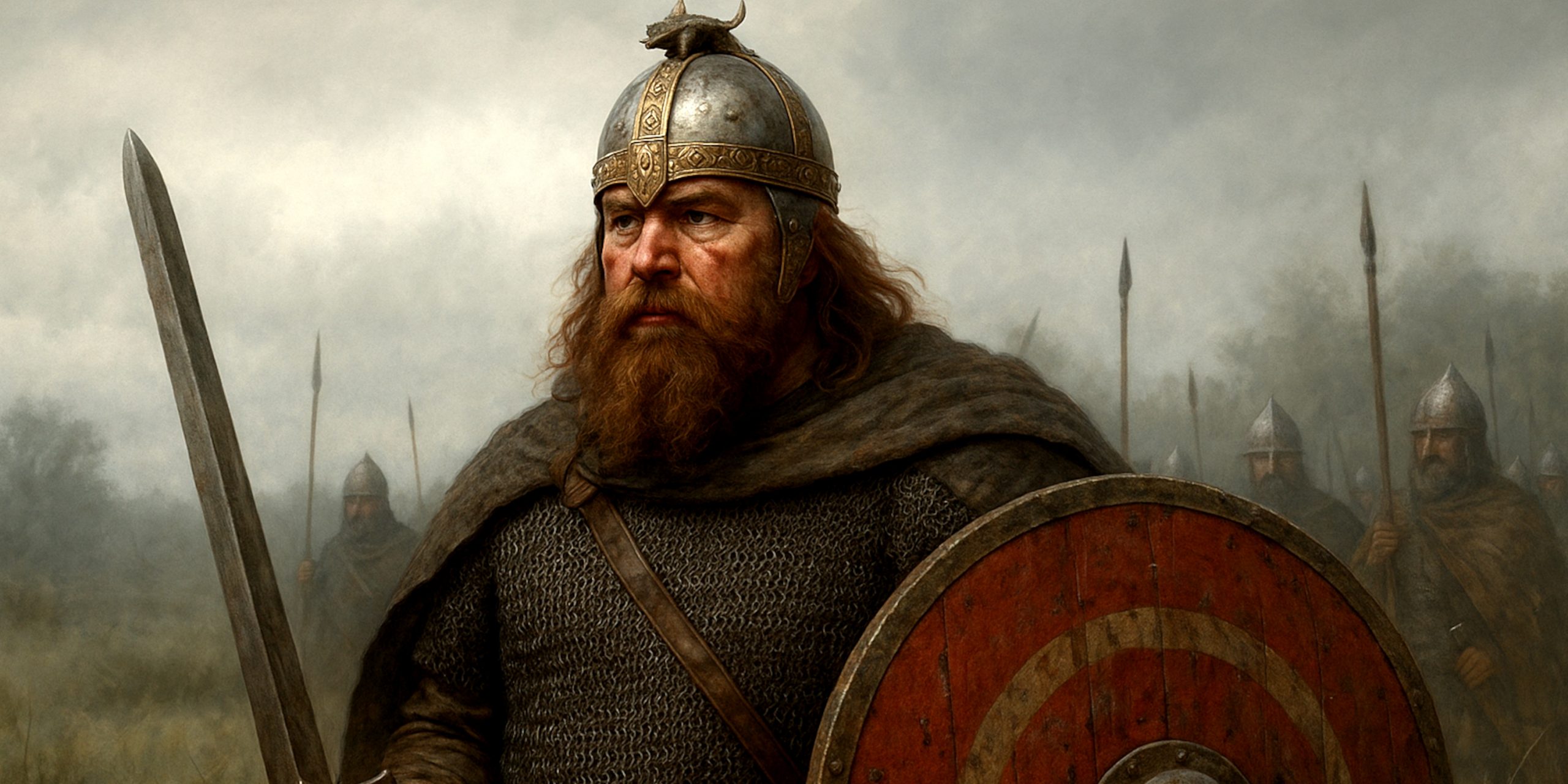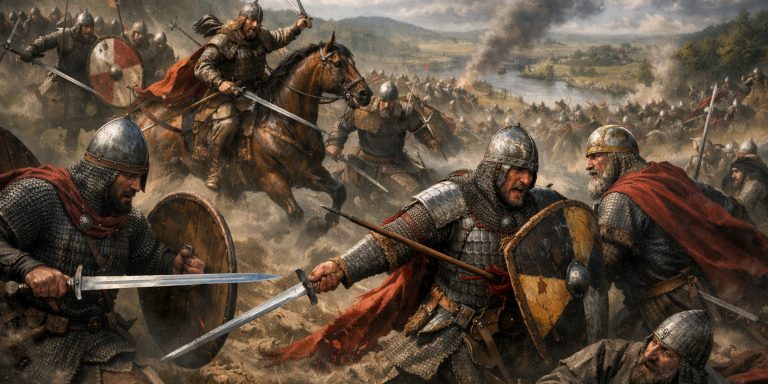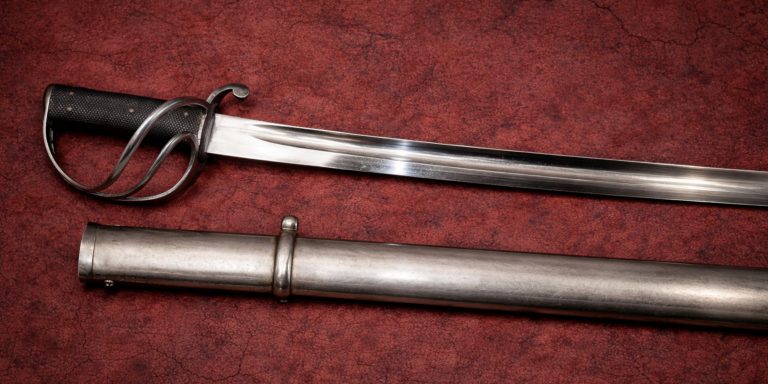
Penda of Mercia remains one of the most fascinating and fiercely independent rulers of early Anglo-Saxon England. A warrior-king who held his own against Christian monarchs on every side, Penda carved out a realm of influence through sheer military skill and political cunning. He ruled a people who were both feared and admired, maintaining pagan traditions long after Christianity had swept across most of the island. To me, Penda represents the last defiant roar of England’s old gods before the Christian age took firm root.
Arms and Armour
Penda’s reign (roughly 626–655 AD) fell within the period when Anglo-Saxon martial culture was reaching its height. Though no weapons can be directly linked to him personally, the broader archaeological record paints a vivid picture of what his warriors would have carried into battle.
Typical Mercian Weaponry:
- Sword: Pattern-welded double-edged swords were prized symbols of nobility. A Mercian thegn would likely have carried a blade similar to those found in the Staffordshire Hoard, richly decorated and balanced for close combat.
- Spear: The most common weapon, often with leaf-shaped iron heads and occasionally barbed. Mercian spears were made for thrusting in tight shield walls.
- Seax: The single-edged short sword or large knife that every warrior owned, used for both fighting and everyday utility.
- Shield: Round wooden shields, bossed with iron and painted or leather-covered. Designs may have reflected tribal or personal identity.
- Helmet: While few survive, the famed Staffordshire Hoard and finds from nearby Sutton Hoo suggest that elite warriors wore ornate iron helmets with intricate inlays and facial guards.
Armour:
- Chainmail shirts were rare and reserved for the elite, typically riveted and knee-length.
- Helmets were status symbols, not mere protection.
- Leather and layered textile armour would have been common among lesser warriors.
It is tempting to imagine Penda himself, broad-shouldered and hardened by war, wearing a chain shirt darkened with oil, gripping a sword of exceptional craftsmanship, and carrying a boar-crested helmet, the ancient symbol of protection and courage.
Battles and Military Acumen
If one judges a king by the wars he fought, Penda stands among the most formidable rulers of his age. His reign was a constant contest for supremacy over the other Anglo-Saxon kingdoms, particularly Northumbria and Wessex.
Major Battles Associated with Penda:
| Year | Battle | Opponent | Outcome | Significance |
|---|---|---|---|---|
| 628 | Battle of Cirencester | West Saxons | Mercian victory | Secured control of the Severn Valley and opened paths into the southwest. |
| 633 | Battle of Hatfield Chase | Northumbria (King Edwin) | Mercian victory | Penda allied with Cadwallon of Gwynedd to defeat and kill King Edwin. |
| 642 | Battle of Maserfield (Oswestry) | Northumbria (King Oswald) | Mercian victory | Penda slew Oswald, cementing his reputation as the scourge of Northumbria. |
| 655 | Battle of the Winwaed | Northumbria (King Oswiu) | Northumbrian victory | Penda was killed, ending Mercia’s pagan leadership. |
Penda’s tactics relied on mobility and shock power. He favoured swift raids, coordinated alliances, and surprise attacks. His ability to forge temporary pacts, such as with the Welsh king Cadwallon, shows a flexible mind that valued results over ideology. Despite being a pagan, he tolerated Christian preachers in his lands, even while cutting down kings who bore the cross.
As a commander, he displayed a ruthless pragmatism. He fought not to conquer by faith but by strength. His death at the Winwaed came during a campaign remarkable for its scale, reportedly involving thirty warbands and allies. The flood-swollen river turned the battle into a slaughter, and Penda’s fall marked the symbolic triumph of Christianity in England.
Where to See Artefacts from His Reign
While no objects can be securely tied to Penda himself, Mercian archaeology offers an astonishing array of finds that illuminate his era:
The Staffordshire Hoard (Birmingham Museum and Potteries Museum, Stoke-on-Trent):
An unparalleled collection of gold and garnet-inlaid weapon fittings from the early 7th century, discovered not far from the heart of old Mercia. The craftsmanship and martial symbolism echo Penda’s time precisely, suggesting treasures stripped from slain warriors in his campaigns.
Sutton Hoo (British Museum):
Though East Anglian, the Sutton Hoo burial reflects the elite warrior culture that Penda both belonged to and fought against. Its helmet and sword remain the quintessential image of early Anglo-Saxon kingship.
Tamworth and Repton Archaeological Sites (Staffordshire):
Both sites were important centres of early Mercia. Repton, later a Viking base, has evidence of elite burials dating back to Penda’s era, possibly his kin. Excavations reveal the shifting power centres of the Midlands during his rule.
Latest Archaeological Findings
Recent excavations across the Midlands continue to expand our picture of early Mercian society:
- Repton: Carbon dating of graves suggests elite activity earlier than once thought, pushing back the foundation of Mercian royal presence into Penda’s time.
- Staffordshire Hoard Analysis: Modern techniques have identified micro-inlays and previously invisible gilding patterns, revealing an astonishing level of sophistication. Some pieces are thought to have been deliberately broken as war trophies, consistent with Mercian practice.
- Tamworth Reconstruction Projects: Ongoing reconstructions of early Mercian halls give us a sense of how Penda’s court might have looked, with timber halls, smoke-filled rafters, and weapon racks gleaming with bronze and iron.
Legacy
Penda’s death at the Winwaed marked more than the end of a king; it signalled the close of an age. With him fell the last serious challenge of paganism to the Christian monarchies of England. Yet, unlike the caricature of a savage heathen, Penda appears as a pragmatic ruler who tolerated diversity and sought alliances wherever useful.
Personally, I find something admirable in his stubborn adherence to the old ways, not as a relic of superstition but as an assertion of cultural identity. Penda’s England was not yet the England of monks and manuscripts; it was a land of spears, oaths, and blood-bound loyalties. His legacy, though largely erased by his Christian successors, endures in the defiant spirit of Mercia itself.
In the quiet displays of the Staffordshire Hoard or the windswept fields near Oswestry, one can almost sense the echo of that final pagan roar, a reminder that England’s early history was forged as much in defiance as in faith.
Watch the documentary:



